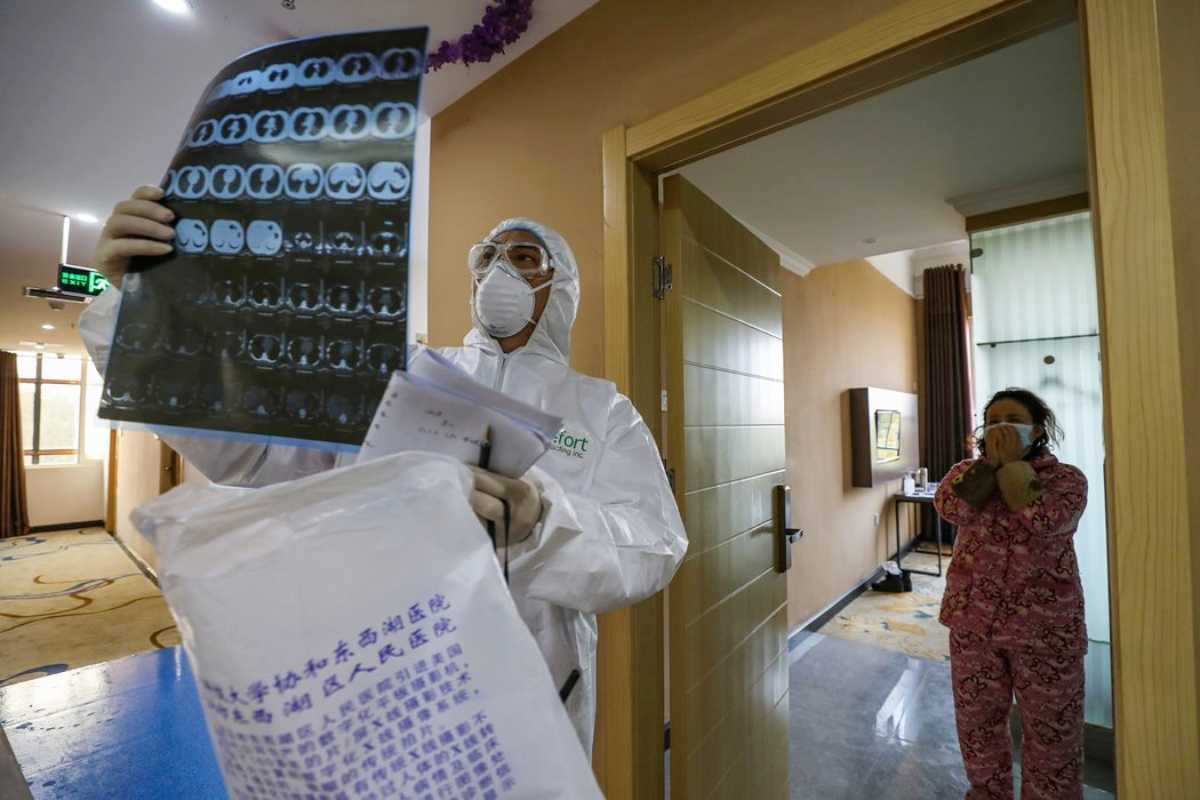Even Without Symptoms, Wuhan Coronavirus May Spread, Experts Fear
A report purporting to describe asymptomatic transmission in Germany has come under fire. But many experts still believe it’s happening.

A doctor examined a lung scan inside a coronavirus quarantine zone in Wuhan, China, on Monday.Credit...Agence France-Presse — Getty Images
By Roni Caryn Rabin
Can individuals infected with the Wuhan coronavirus spread it to others even if they aren’t showing symptoms?
It’s one of the most important questions confronting scientists. If even asymptomatic people can spread the virus, then it will be much, much harder to slow its spread.
Doctors in China claimed asymptomatic transmission was possible, and a letter published Jan. 30 in the New England Journal of Medicine appeared to back them up.
In the letter, scientists described a cluster of infections in Germany that had started with a traveler from Shanghai. The traveler had seemed healthy during her four-day visit to Bavaria, the researchers reported, and started feeling ill only after she boarded a return flight to China.
That report heightened anxiety among scientists worldwide, who said the finding suggested that containment of the Wuhan coronavirus would be nearly impossible.
But now health officials in Germany have raised doubts about the accuracy of that report. The visitor to Germany had “mild unspecific symptoms” while she was still in Germany, said Marieke Degen, a spokeswoman with the Robert Koch Institute, Germany’s public health institute, headquartered in Berlin.
The woman’s symptoms, including back pain, had been vague, and she had taken antipyretic medication, according to Bavarian health authorities and scientists at the institute. Antipyretic drugs are used not only to relieve fever, but also as painkillers and for their anti-inflammatory properties.
Health officials reported their findings last week to the Early Warning and Response System of the European Centre for Disease Prevention and Control, Ms. Degen said; their criticism was first reported by Science magazine.
Whatever the inaccuracies in the journal report, many experts remain concerned about the potential for coronavirus to be spread by asymptomatic individuals, in large part because of anecdotal information received from their colleagues in China.
“This paper may or may not be flawed — it needs further investigation,” said Dr. Anthony Fauci, director of the National Institute of Allergy and Infectious Diseases. “But I don’t think it negates the concept.”
“We had been getting reports from highly reliable people in China — scientists, investigators and public health people who we’ve known over the years — and they’ve been telling us, ‘There’s asymptomatic disease, for sure, and we are seeing asymptomatic transmission,’” Dr. Fauci said.
Asymptomatic transmission is unlikely to be driving the epidemic within China, he added, but “it complicates our job.”

Even if asymptomatic patients are spreading the coronavirus, the vast majority of infections will occur from patients showing symptoms, said Dr. Maria Van Kerkhove of the World Health Organization. Credit...Denis Balibouse/Reuters
If the early symptoms include such common complaints as back pain, then infected individuals and their doctors are unlikely to consider the possibility that the patient is infected with a coronavirus, said Marc Lipsitch, professor of epidemiology at Harvard T.H. Chan School of Public Health in Boston.
“From a practical perspective, that is almost the same as if she had no symptoms at all,” Dr. Lipsitch said. “Headaches are very common, and the coronavirus is not the principal cause thereof, and they’re not observable by a third party.”
If the first symptom is common and vague, he added, “then the public health challenge of figuring out who’s infectious is about as great as if it was truly asymptomatic.”
Dr. Maria Van Kerkhove, acting head of emerging diseases at the World Health Organization, said Tuesday that the organization had been aware of reports of individuals who might have transmitted the Wuhan coronavirus before their symptoms appeared or very soon after being infected.
But experience with other diseases indicated that many people who were believed to have been asymptomatic actually did experience symptoms.
“It is possible that there may be individuals who are asymptomatic that shed virus, but we need more detailed studies around this to determine how often that is happening, and if this is leading to secondary transmission,” Dr. Van Kerkhove said.
Whatever the answers to those questions, however, most viral respiratory infections are spread through the coughs and sneezes of symptomatic patients, experts say.
The letter at the center of the controversy describes a healthy 33-year-old businessman in Germany who had developed a sore throat, chills and muscle aches on Jan. 24, with a fever spiking to 102.4 degrees Fahrenheit the next day, along with a cough.
Before he became ill, he had met in Munich on Jan. 20 and Jan. 21 with a Chinese business partner. A resident of Shanghai, she had been in Germany from Jan. 19 to Jan. 22. The report said that she was healthy during her stay but got sick during her flight back to China. She tested positive for infection with the Wuhan coronavirus on Jan. 26.
Chinese authorities alerted German health officials, and the businessman was tested and found positive for the infection. On Jan. 28, three additional employees of the German company tested positive for the coronavirus. Two of them had not had any contact with the woman from Shanghai.
All of the infected were admitted to the hospital, where they were isolated and monitored. None developed severe disease.
The authors of the report, researchers in Munich and Berlin, said it was “notable that the infection appears to have been transmitted during the incubation period” of the virus. The woman suffered only a brief, mild illness and recovered.
Dr. Michael Hoelscher, one of the authors, told Science magazine that he and his colleagues had not interviewed the Chinese woman who had been ill, and relied on the accounts given by her German colleagues, who said she did not appear to have had any symptoms. Dr. Hoelscher could not be reached for comment.
Researchers from the Robert Koch Institute and the Health and Food Safety Authority of Bavaria did interview the woman on the phone, Ms. Degen said, which is how they learned that she might have had symptoms.
Julia Morin, a spokeswoman for the New England Journal of Medicine, said, “All we can say right now is that we are looking into the matter.”
Knvul Sheikh contributed reporting.
Original Link: The New York Times
.png)






